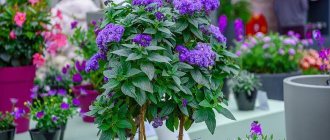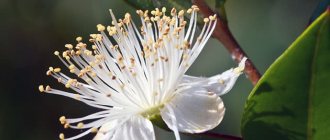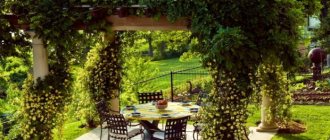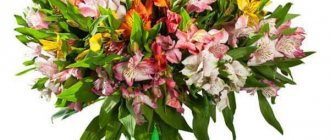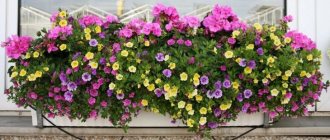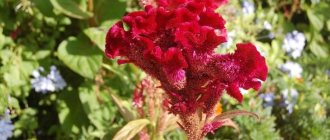The bulbous perennial plant Scilla is a member of the Asparagus family. However, some time ago this flower was classified as a member of the lily or hyacinth family. This plant is also called scylla. Often such a flower is mistaken for a snowdrop or woodleaf. This genus includes approximately 90 different plant species. Under natural conditions, they can be found in Africa, Asia and Europe, and they prefer to grow on plains and mountain meadows. The name of this flower comes from the Greek name for sea onion “skilla”, the fact is that it was previously a representative of this genus. This plant is highly resistant to frost and disease, and it is also very beautiful and can quickly adapt to any environmental conditions.
Description, varieties and varieties: between scylla and its species
Scilla is a herbaceous perennial of the Asparagus genus.
Its most common species is the Siberian woodleaf (Scilla siberica). In nature, the Siberian scylla lives in forest lawns and meadows of Eastern and Western Europe, in the oak forests of the North Caucasus and in the Crimea - but it has not reached Siberia. Morphological characteristics:
- plant height 10-12 cm;
- basal leaves are broadly linear, linear, bright green, their length is about 13-15 cm, number - 2-4 pieces. At their thin tips they bear a point in the form of a light tip, formed by rough cells of mechanical tissues. The plant needs this “sword” to break through frozen soil and snow crust;
- aboveground seed germination, from the beginning of March;
- flowers are bright blue, drooping, cup-shaped, 1.5 cm in diameter, with six petals, in inflorescences on average 4-5 pieces;
- fruit type - capsule. The seed-bearing capsules fall off and ripen in the ground;
- The ovoid, elongated bulb is small - the diameter reaches only 2-3 cm. The covering scales are brown-violet.
Attention! Flowering of the Siberian scilla in open ground begins in early to mid-April, 7-10 days after the snow leaves, after the first thawed patches appear. Flowering duration is from 15 to 20-23 days. Honey plant, loved by wasps and bees.
The leaves appear almost at the same time as the flower stalks and die off before maturing in the seed pods. The growing season begins in spring and ends until autumn; in summer there is a dormant period. In autumn, new roots of the bulbs appear, the rudiments of leaves and flowers develop. During the resting phase, in winter, their slow development continues.
Scylla "bell-shaped" (Endymion Hispanica)
The "bell-shaped" scylla or "Spanish endymion" originates from the forests of Spain, Portugal and France. The plant can be considered one of the most beautiful species of scilla.
A medium-sized peduncle is decorated with blue or pink flowers, in the form of a large bell 2-3 cm in size. There can be up to 8 flowers on one peduncle, making up a marvelous “fluffy” bunch.
The bell-shaped scylla begins flowering at the end of May and ends in June. The variety of bell-shaped varieties cannot but please the eye and delight gardeners.
The most popular varieties of bell-shaped scylla are:
Sky Blue, a variety with large sky-blue flowers and blue veins located on large peduncles.
Rose Queen, a vibrant variety with pink flowers and lavender undertones.
La Gradence will surprise you with its large white flowers, collected in lush clusters, and a delicate aroma.
Rosabella, pink-lilac flowers in inflorescences, will fill the garden with fragrance. Plant height is up to 25 cm. The variety is in demand among florists and landscape designers.
In addition to those described above, the bell-shaped scylla includes scillas of the following varieties: Everest, Blue Pearl, Blue Queen, Blue Giant, Queen Pinks and others.
Types, subspecies, varieties of scilla
- Siberian bluebell - lives in the same place as the main species. The main forms have white, blue, blue flowers, and occasionally pale pink.
- Proleska Armenian is a native of the slopes of Southern Transcaucasia, a resident of the subalpine belt of North-East Turkey. The subspecies grows in large groups and prefers partial shade. The flowers are bright blue, rich, the pedicels are curved, long arrows bear neat inflorescences of 3-4 pieces.
- The Caucasian scilla came from the forest-steppe of Transcaucasia. Tall peduncles proudly bear its blue-violet flowers on straight stalks.
Scilla Caucasian
The main variety for European countries is Spring Beauty. Spring Beauty blooms beautifully - with dark purple flowers, large (up to 3 cm). The peculiarity of the variety is the inability to sow seeds.
Another variety, distinguished only by snow-white flowers with snow-white stamens, is Alba, which blooms later than the main form and 7-10 days longer. Gives a successful combination with purple Spring Beauty.
Planting scilla and basic requirements
Planting, like replanting, is carried out after the leaves die, in the second or third decade of July or at the beginning of July, unlike other species that are planted in the fall. Bulbs of this type are not subject to long-term storage. Scilla can be replanted during flowering, but it is better to do this during the dormant period, namely in the summer.
Attention! The planting depth of the bulb is usually equal to its height (2-6 cm): large specimens are planted deeper, smaller ones are planted at a shallower depth.
When planting or transplanting, the sequence of actions is as follows:
- bulbs are dug up;
- clean clods of earth, separate children;
- to prepare the substrate, forest soil, peat, rotted litter with bark particles are added to the garden soil; if necessary, mineral fertilizer is applied on poor soils;
- planted, maintaining a distance of 4-6 cm, after compacting the soil mixture, watering is carried out. Flowering of scylla grown from bulbs begins in 2-3 years.
Advice. Self-seeding should be avoided: the seed pods crumble and crack. In order not to disturb decorative compositions, unauthorized sowing is prevented by collecting the boxes or removing the testes before they fall off.
Sowing of seeds is carried out immediately after collecting them. When the seed pods turn yellow or begin to crack, the seeds can be considered suitable for sowing.
Growing scilla is practiced in any flower beds - from tree trunks to rockeries. Things to consider when planting:
- soil requirements: slightly acidic, drainable, fertile, light, moist, but not swampy. It will take root on clay soils when enriched with leaf humus and peat;
- Location requirements: loves partial shade and sunny places. In the first or second year of planting, it is useful to mulch areas with intense sun with peat and litter, removing the mulch after the snow has gone;
- feeding requirements: will appreciate soils enriched with peat and leaf humus;
- care requirements: timely watering followed by shallow loosening, light mulch, mineral-nitrogen fertilizer.
Scylla growing conditions
Lighting
Scilla loves good light, but also grows in partial shade. Scilla species that bloom in spring need to be planted in sunny areas. And those blueberries that bloom in June will feel better in partial shade or in the grass, since solar activity is much higher.
Soil features
Scylla prefers loose soil, which includes soil rich in organic matter and leaf humus. It is advisable to add forest soil with bark and leaves to the garden soil for planting. The soil should be slightly moist. Water stagnation should not be allowed. The soil for scylla should be light and well-drained.
Watering and humidity
Scilla likes moisture, not wetness. A flowering plant should be watered carefully, trying to ensure that as little water gets on the flowers as possible - then the plants retain their decorative properties longer.
Fertilizers for Scylla
Some gardeners think that garden scilla is not so far removed from the wild species and therefore does not need feeding. But this is a mistaken opinion. You can do without fertilizers, but in this case the plant will be weak and the flowering will not be as lush.
It is necessary to fertilize with minerals: potassium, phosphorus and nitrogen. In the fall it is better to fertilize with granular or slowly dissolving fertilizers, and in the spring with liquid fertilizers.
Care: what does a Siberian like?
Caring for Siberian scilla or spring theses:
- needs abundant irrigation during drought. Vegetable light mulch will give a good effect;
- before watering, it is worth loosening the soil to a depth of 2-3 cm, after irrigation - mulch with organic matter;
- responsive to the application of organic matter and mineral fertilizers in early spring; after flowering in the spring, the flower stalks are cut off, the leaves are removed only after they have completely died off;
- for the winter in open ground it needs light shelter. In protected areas, near bushes and trees, it overwinters in the presence of snow without shelter.
Attention! Low temperatures in summer retard plant development and all stages of organogenesis, i.e. formation of the main organs - leaves, flowers. For full formation, temperatures above +20 C are required for 3 months.
Optimal location
Siberian blueberry loves the sun, but also grows well in partial shade. The main thing is that it is not a too dry place with scorching sun all day long, otherwise it will disappear. Swampy and waterlogged areas are also not suitable for it. When planting for early flowering, it is better to choose places on the southern slopes. Shady areas delay the flowering period.
Fertilizer and feeding
There is an opinion that primroses do not need fertilizer. This is wrong. In the open ground of the garden, a fertilizer of a nitrogen-mineral complex, potassium is usually applied on the snow or after it melts, as well as at the time of flowering or at the bud stage.
They use nitrophoska, azophoska, nitroammophoska, and complex microfertilizers. Bulbs have little need for the latter.
Reproduction: to multiply and multiply
Scylla reproduces by seeds budding into daughter two- and three-year-old bulbs. An adult bulb produces small offspring - usually 1-2 pieces. per season, only the white subspecies of the Siberian woodle gives up to 5 children.
Attention! The shell of the scilla bulbs is thin; keeping them open threatens the scales drying out and death.
Sometimes for propagation they use the method of cutting out the bottom and planting it in a separate container. After the babies appear on the bottom, they are separated and then transplanted. With normal scylla propagation in open ground, the mother bulb can produce 2-5 daughter bulbs, and when using this agricultural technique, 20-28 bulbs.
Possible difficulties
Bulb rotting, mold formation on the soil surface
Reason: 1) systematic waterlogging of the soil, 2) lack of drainage.
Poor, short flowering, weak shoots
Reason: 1) poor soil, 2) lack of fertilizing during the flowering and growing season.
Limp, yellowing leaves, drooping buds, rapidly fading flowers, wrinkled bulbs, dry leaf ends
Reason: 1) poor and infrequent watering, 2) prolonged exposure of the plant to direct sunlight.
The appearance of brown spots and small cobwebs on the stems and leaves
Reason: 1) pest damage.
Diseases and pests: who is the blueberry afraid of?
In open ground, like all bulbous plants, it is affected by gray rot, bulb rot, Achellenchoides and other ailments.
- Gray rot usually affects all parts of the bulb. Dense spots of necrosis form on its body, the green parts and scales of the shell are covered with dirty gray mold fluff.
- Achellenchoides affects the green parts, the bulb itself. The scales turn brown, necrosis appears, and ring rot is visible on the cut.
- Bulb rot is caused by fungal infections. Most often these are sclerotinia, septoria, fusarium. Their main signs are yellowing, fading leaves, necrotic formations on the bulbs.
Severely damaged specimens are disposed of; only those affected by the disease can be saved by treating them with a fungicide before planting.
Scilla is also susceptible to attack by rodents, seeking to feast on the tender bulb in the fall and its sprouts in the spring.
The most dangerous pest is the meadow mite, which penetrates through the bottom and feeds on the sap of the scales. Insecticides and acaricides are used against the pest - Actellik, Agrovertin, Calypso and others. Another pest is the onion hoverfly. The fly larva penetrates the core of the bulbs, gnawing it out. Bulbs that are attacked die. To combat the hoverfly, available insecticides are used, as in the case of attacks by other enemies of the crop - beetles, mole crickets.
First steps after purchase
You should pay attention to the leaves, stems, flowers or buds when choosing Scilla in the store. If dark spots, dry leaves, and small insects are noticeable, then the plant is sick or damaged by pests. But the greenery of rich color, leaves without tears, holes or cuts, bright, not drooping flower heads, dense stems say that Scilla is healthy and can be purchased without fear.
At home, the plant is given a short quarantine. It would not be superfluous to treat pests with special means. After this, Proleska can be assigned a permanent location.
The bulbs are also subject to a thorough inspection if you want to try growing Scilla yourself. How healthy and beautiful the new plant will be depends on the quality of the planting material. The bulbs should be dense, without rotten spots or signs of mold.
Scilla and its neighbors: combination with other plants
To create compositions, plants that bloom at the same time are selected, compatible with the crop - or contrasting. It is important to take into account that annuals, when they bloom, create empty spaces around the woodland that is not protected from the sun. Planting perennials nearby creates shade and protects the bulbs from overheating in the heat.
Of the perennials, they look spectacular next to ferns and peonies, and others that have not had time to bloom. They also go well with simultaneously blooming snowdrops, crocuses, pushkinias, daffodils and other inhabitants of the bulb garden.
In mixborders and borders, under bushes and in combination with them, in monochrome plantings around trees, under the canopy of a garden - Siberian Scilla is appropriate everywhere. Large group plantings are spectacular, those same blue islands that captivate the eye in the photo. Compositions in combination with stones are good - in the design of an alpine slide and rock garden. Blue-eyes are also appropriate on open lawns and lawns; they are especially expressive among awakening bushes and bare trees.
In general, the touching primrose is unpretentious to grow. It survives on most soils and is stoic about poor soils and poor watering. It propagates easily, especially by self-sowing. It will not tolerate complete indifference to its beauty, but it will respond to the warmth of its owner’s hands with a sea of shy blue-blue flowers.
Scilla or Scylla in garden landscape design
Thanks to the tenderness of the inflorescences of Scilla, the perennial is widely used to decorate the spring garden. It looks good in single plantings, combining perfectly with the awakening greenery of shrubs and trees. It can also be used to organize group flower beds made up of primroses.
You can create a flower bed from flowers of different flowering times; when the Blue Scilla has faded, another type of plant may bloom in its place, for example, Peony, which will cover the Scilla's planting site with its lush crown.
The Scylla flower looks good cut and in spring bouquets. Its delicate buds and bright greenery will not leave any representative of the fair sex indifferent.
